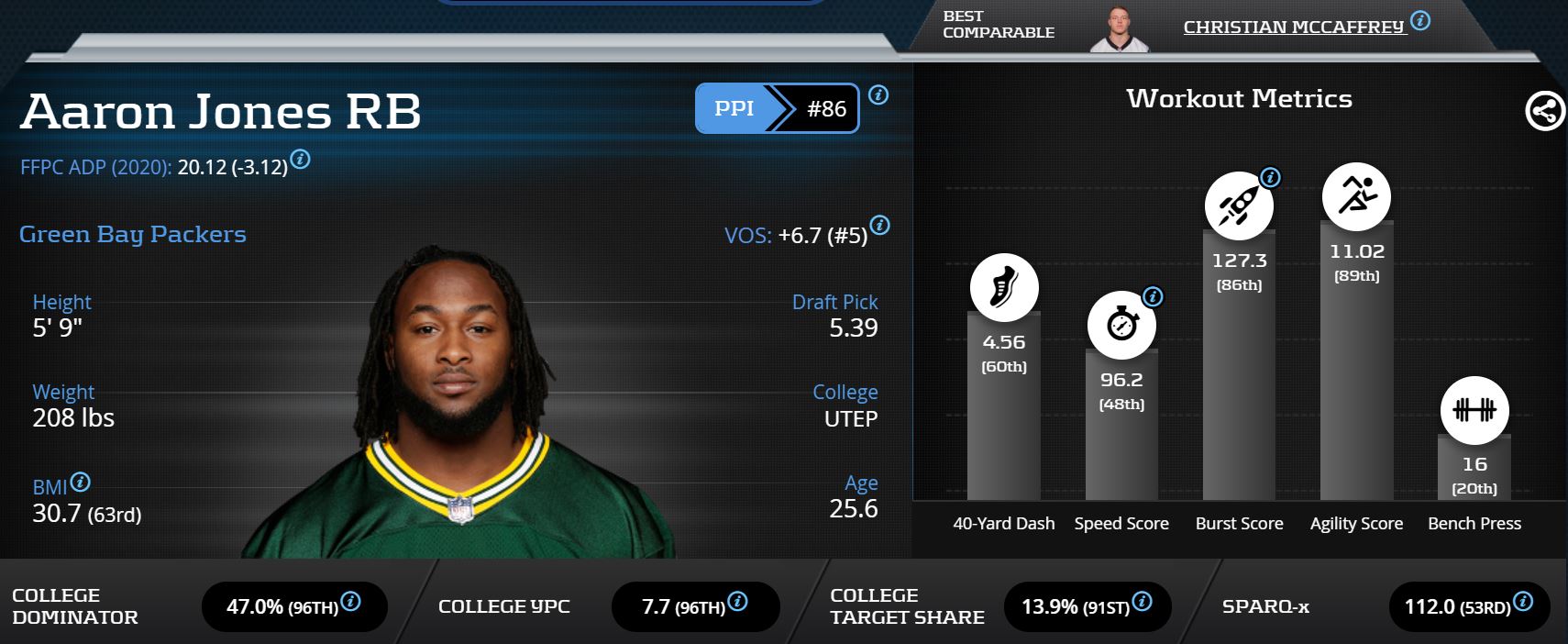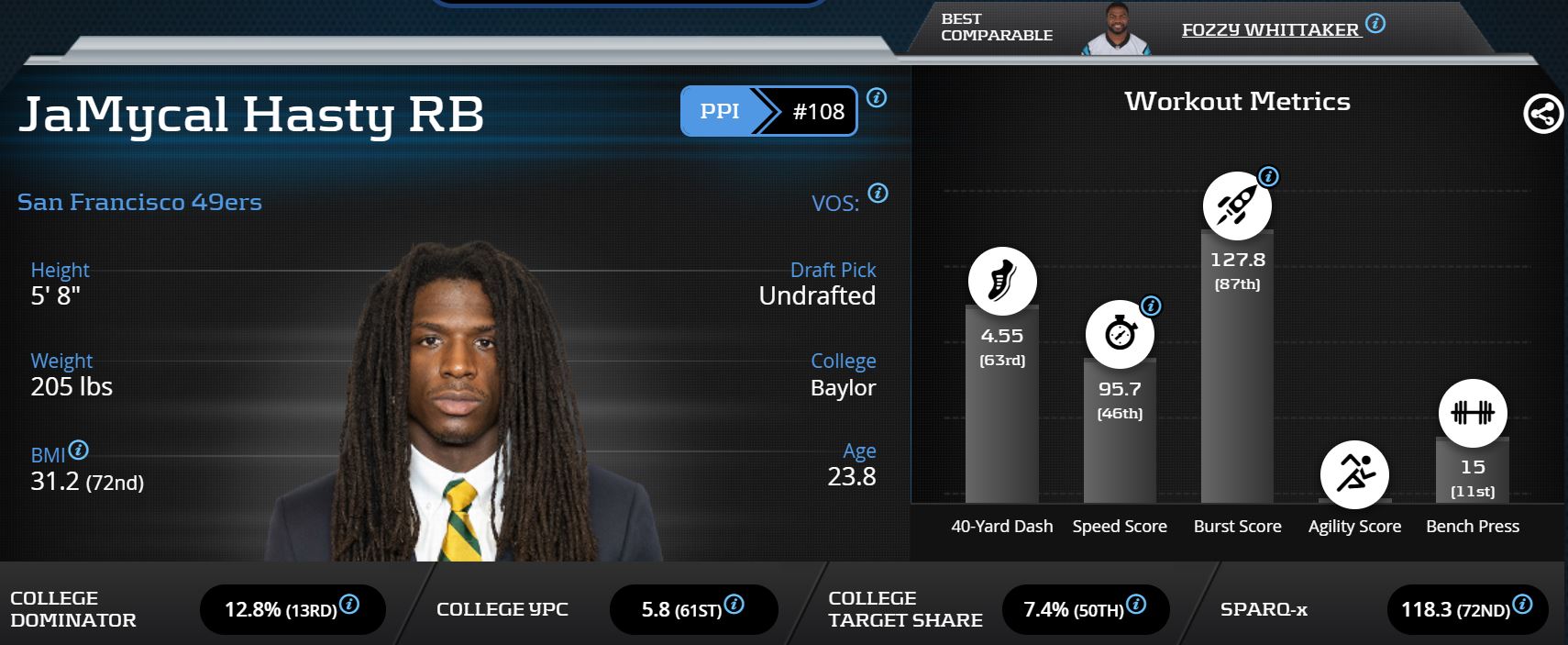When trying to pinpoint the next Aaron Jones, we first need to take a look at who he is. Let’s go under the hood with advanced stats, metrics, and analytics to paint a picture of this small school stud. Hailing from UTEP, Jones was a fifth round pick in the 2017 NFL Draft by Green Bay. He performed admirably at the Combine, his profile highlighted by a 127.3 (86th-percentile among qualified running backs) Burst Score and a 11.02 (89th-percentile) Agility Score. Jones slotted in behind perennial fantasy cock-block Jamaal Williams from day one, and Ty Montgomery was soaking up receiving work. Jones’ rookie effort was nothing to write home about, but the coaching staff saw enough to ramp his workload up over time.
Jones’ 13.9 (91st-percentile) College Target Share started to come back around for him as he progressed, growing from 18 (No. 68) targets in 2017, to 35 (No. 33) in 2018, then 68 (No. 11) last year. He’s made himself into a true three-down back in terms of talent and efficiency, with high marks on many money categories on PlayerProfiler.com. These include recording 501 (No. 6) Yards Created and 86 (No. 4) Evaded Tackles last year. It’s simply bad coaching that’s keeping him from being a Christian McCaffrey-level usage monster. This is before even mentioning the league-leading 19 touchdowns in 2019. Jones has it all. What current young backs fit this profile?
Anthony McFarland, Pittsburgh Steelers
Anthony McFarland, an early declare, parlayed solid production and 4.44 (92nd-percentile) wheels into a mid-round pick to Pittsburgh, an attractive spot for a young back with time to grow. James Conner is a solid all-around player, but he is markedly injury-prone and the team is not beholden to him after this season. The Aaron Jones checklist of entering a backfield with an uncertain lead dog and uninspiring backups is a green light so far. McFarland also maintained an above-average 7.6-percent (54th-percentile) College Target Share. Important to note considering Ben Roethlisberger funneled 100 targets into Conner and Jaylen Samuels when he was last healthy in 2018. If any of Ben’s throwing prowess starts to dwindle coming off elbow surgery, expect those low aDOT throws to stick around.
Check out Anthony McFarland’s 2020 Projection on PlayerProfiler’s “World Famous” Draft Kit:
McFarland’s second gear is apparent. If he wasn’t outrunning defenders at the second level, there were plenty of jukes and broken tackles on film to support a Jones-ian talent profile at the pro level. His talents can be unlocked behind the perennially great Steelers line. We’ve got the uncertain backfield, plus athleticism, game-breaking speed and make-defenders-miss-ability. That meets our standards. All it will take is a long touchdown run in the preseason or poor play from Conner to fire his ADP to unattainable prices. The time is now to acquire McFarland and nestle him safely on your taxi squad.
Darrynton Evans, Tennessee Titans
Darrynton Evans enters the league as the clear backup to the big dog himself, Derrick Henry. The athletic numbers and production speak volumes for Evans. He excelled across the board at the Combine, clocking a 4.41 (96th-percentile) 40-yard dash with an upper-echelon Speed Score and Burst Score. We also love when a player excels in their final season. Evans rolled up a 255 carry, 1,480-yard effort at Appalachian State last year, along with 23 touchdowns.
With Dion Lewis out of the picture, there’s hope for Evans to immediately earn meaningful snaps as a pass-catcher with the Titans showing no desire to ramp up Henry’s pass-catching opportunities. Every move of Tennessee’s offseason has been bent on repeating last year’s offensive success. This didn’t include targeting Henry, who saw only 25 (No. 49) targets last year as opposed to 303 (No. 1) carries. Enter Evans. While not a prolific pass-catcher in school, his targets and receiving production increased every year, and he’s certainly got more of a satellite back-plus profile than Henry. Here we have a clear path to touches early on with the opportunity for early inclusion into the rushing attack on one of the league’s rush-happiest offenses. Yes please.
JaMycal Hasty, San Francisco 49ers
This is a deeper dive play for those of you still engaging in startups and offseason waivers. The Kyle Shanahan-led rushing attack is always among the highest value spots to target. The 49ers moved on from Matt Breida this offseason, freeing up 100-plus carries in their No. 2 ranked attack in terms of run plays per game. Now, we certainly aren’t grafting Breida’s workload onto an undrafted JaMycal Hasty, but it’s important for a player to have room to prove himself, and there are plenty of carries to go around in San Fran, especially with Tevin Coleman coming off the dreaded high ankle sprain.
Hasty enters a similar situation as Aaron Jones did as a rookie, behind two average running backs that the team isn’t heavily invested in. Hasty also has at least some receiving work on his resume, which can help him stay on the field while spelling the backs in front of him. The profile in and of itself isn’t a slam dunk, but the price sure is. Hasty is a final round pick in rookie drafts, if not undrafted. He can be acquired for virtually free in offseason waivers or as a dynasty trade throw-in. For a player with above-average athleticism on an offense built for springing running backs out of obscurity (just ask Raheem Mostert), Hasty is worth those couple of FAAB dollars.





